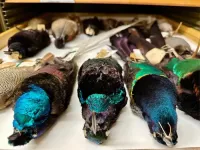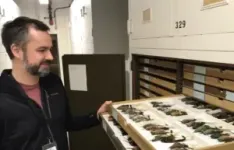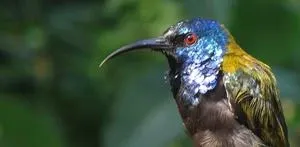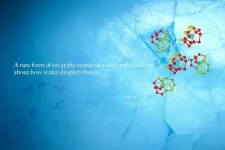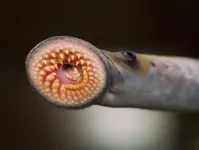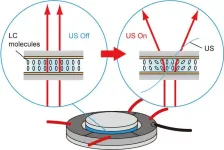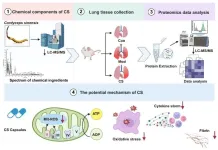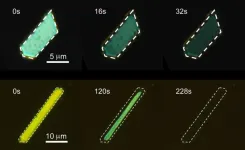(Press-News.org) The color palette of the birds you see out your window depend on where you live. If you’re far from the Equator, most birds tend to have drab colors, but the closer you are to the tropics, you’ll probably see more and more colorful feathers. Scientists have long been puzzled about why there are more brilliantly-colored birds in the tropics than in other places, and they’ve also wondered how those brightly-colored birds got there in the first place: that is, if those colorful feathers evolved in the tropics, or if tropical birds have colorful ancestors that came to the region from somewhere else. In a new study published in the journal Nature Ecology and Evolution, scientists built a database of 9,409 birds to explore the spread of color across the globe. They found that iridescent, colorful feathers originated 415 times across the bird tree of life, and in most cases, arose outside of the tropics– and that the ancestor of all modern birds likely had iridescent feathers, too.
“For decades, scientists have had this hypothesis that there are brighter or more colorful species of birds in the tropics,” says Chad Eliason, a research scientist at the Field Museum in Chicago and the paper’s lead author. “We wanted to find the mechanism to help us understand these trends-- how these bright colors got there and how they spread across the bird family tree over time.”
There are two main ways that color is produced in animals: pigments and structures. Cells produce pigments like melanin, which is responsible for black and brown coloration. Meanwhile, structural color comes from the way light bounces off different arrangements of cell structures. Iridescence, the rainbow shimmer that changes depending how light hits an object, is an example of structural color.
Tropical birds get their colors from a combination of brilliant pigments and structural color. Eliason’s work focuses on structural color, so he wanted to explore that element of tropical bird coloration. He and his colleagues combed through photographs, videos, and even scientific illustrations of 9,409 species of birds-- the vast majority of the 10,000-ish living bird species known to science. The researchers kept track of which species have iridescent feathers, and where those birds are found.
The scientists then combined their data on bird coloration and distribution with a pre-existing family tree, based on DNA, showing how all the known bird species are related to each other. They fed the information to a modeling system to extrapolate the origins and spread of iridescence. “Basically, we did a lot of math,” says Eliason.
Given how modern species are related to each other and where they're found, and overall patterns of how species form and how traits like colors change over time, the modeling software determined the most likely explanation for the bird colors we see today: colorful birds from outside the tropics often came to the region millions of years ago, and then branched out into more and more different species. The model also revealed a surprise about the ancestor of all modern birds.
For background, birds are a specialized group of dinosaurs-- the earliest known bird, Archaeopteryx, lived 140 million years ago. A sub-group of birds called Neornithes evolved 80 million years ago, and this group became the only birds (and dinosaurs) to survive the mass extinction 66 million years ago. All modern birds are members of Neornithes. The model produced by Eliason and his colleagues suggests that the common ancestor of all Neornithes, 80 million years ago, had iridescent feathers that still glitter across the bird family tree.
“I was very excited to learn that the ancestral state of all birds is iridescence,” says Eliason. “We’ve found fossil evidence of iridescent birds and other feathered dinosaurs before, by examining fossil feathers and the preserved pigment-producing structures in those feathers. So we know that iridescent feathers existed back in the Cretaceous-- those fossils help support the idea from our model that the ancestor of all modern birds was iridescent too.”
The discovery that the first Neornithes was likely iridescent could have important implications for paleontology. ”We’re probably going to be finding a lot more iridescence in the fossil record now that we know to look,” says Eliason.
While this new study sheds light on how iridescence spread through the bird family tree over the course of millions of years, some big questions remain. “We still don’t know why iridescence evolved in the first place,” says Eliason. “Iridescent feathers can be used by birds to attract mates, but iridescence is related to other aspects of birds’ lives too. For instance, tree swallows change color when the humidity changes, so iridescence could be related to the environment, or it might be related to another physical property of feathers, like water resistance. But knowing more about how there came to be so many iridescent birds in the tropics might help us understand why iridescence evolved.”
This study was contributed to by Chad M. Eliason of the Field Museum’s Grainger Bioinformatics Center and Negaunee Integrative Research Center, Michaël P.J. Nicolaï of Ghent University and the Royal Belgian Institute of Natural Sciences, Cynthia Bom of Vrije Universiteit Amsterdam, Eline Blom of Naturalis Biodiversity Center, Liliana D’Alba of Ghent University and Naturalis Biodiversity Center, and Matthew D. Shawkey of Ghent University.
###
END
Tokyo, Japan – Ice is far more complicated than most of us realize, with over 20 different varieties known to science, forming under various combinations of pressure and temperature. The kind we use to chill our drinks is known as ice I, and it’s one of the few forms of ice that exist naturally on Earth. Researchers from Japan have recently discovered another type of ice: ice 0, an unusual form of ice that can seed the formation of ice crystals in supercooled water.
The formation of ice near the surface ...
Lack of persistence of CAR T cells is major limiting step in CAR T-cell therapy
Made by fusing an immune-stimulatory molecule to a protein from cancer cells, the therapy selectively targets CAR T cells and enhances their functionality and persistence in the body, extending their attack on cancer.
The therapy, called CAR-Enhancer (CAR-E), also causes CAR T cells to retain a memory of the cancer, allowing them to mount another attack if cancer recurs
BOSTON – Even as they have revolutionized the treatment of certain forms of cancer, CAR T-cell therapies ...
EVANSTON, Ill. --- One of just two vertebrates without a jaw, sea lampreys that are wreaking havoc in Midwestern fisheries are simultaneously helping scientists understand the origins of two important stem cells that drove the evolution of vertebrates.
Northwestern University biologists have pinpointed when the gene network that regulates these stem cells may have evolved and gained insights into what might be responsible for lampreys’ missing mandibles.
The two cell types — pluripotent blastula cells (or embryonic stem cells) and neural crest cells — are both “pluripotent,” ...
A new study published in Nature Genetics by the Lymphoid Development Group at the MRC Laboratory of Medical Sciences has reveals that the contribution of cells expressing maternal or paternal X chromosomes can be selectively skewed in different parts of the body. The study leverages human data from the 1000 Genomes Project combined with mouse models of human X chromosome-linked DNA sequence variation to advance our fundamental understanding of development in biologically female individuals who have two X chromosomes.
Until now, it was thought that the usage of maternal and paternal X-chromosomes was similar throughout the body. The ...
Distrust of health experts and credulity towards misinformation can kill. For example, during the Covid-19 crisis, high-profile health experts received death threats while misinformation went viral on social media. And already long before the pandemic, easily preventable but potentially serious diseases had been making a comeback around the world due to vaccine hesitancy – often powered by conspiracy theories.
But what feeds this lack in trust in reliable sources of health information? Can it perhaps be mitigated? Those are the subjects of a new study in Frontiers in Medicine by researchers from the US.
“Here we show that individuals who ...
It is no mystery that light is essential to human life. Since the discovery of fire, humans have developed various artificial light sources, such as incandescent lamps, gaslights, discharge lamps, and light-emitting diodes (LEDs). The distribution and intensity of artificial lights indoors are important factors that affect our ability to study and work effectively and influence our physical and mental health. Consequently, modern artificial light sources are designed with these psychological elements to achieve the best aesthetics. ...
A recent study from China has reported that Cordyceps sinensis (CS), a traditional Chinese medicinal fungus, can ameliorate idiopathic pulmonary fibrosis (IPF) in mice by inhibiting mitochondrion-mediated oxidative stress. The research, conducted by a team led by Huan Tang and Jigang Wang from the Institute of Chinese Materia Medica at the China Academy of Chinese Medical Sciences, was published in Wiley's MedComm-Future Medicine.
Idiopathic pulmonary fibrosis is a chronic and progressive lung disease characterized by a decline in lung function, ultimately leading to respiratory failure and a significantly reduced quality of life for patients. With a median ...
A rose by any other name is a rose, but what of a crystal? Osaka Metropolitan University-led researchers have found that single crystals of four anthracene derivatives with different substituents react differently when irradiated with light, perhaps holding clues to how we can use such materials in functional ways.
Graduate student Sogo Kataoka, Dr. Daichi Kitagawa, a lecturer, and Professor Seiya Kobatake of the Graduate School of Engineering and colleagues compared the photoreactions of the single crystals when the entire anthracene crystal was irradiated with light.
For two ...
Over the past few decades, many parts of the world have experienced record-breaking wildfire events—a trend that is, unfortunately, expected to rise. These extreme events not only result in mass evacuations, but also release greenhouse gases like carbon dioxide, pose risks to life, devastate buildings and essential infrastructure, and fundamentally disrupt and detrimentally transform native ecosystems. In response to the increased risk of catastrophic wildfires, many planning and site design practices have sought to protect the trends and status quo of land development. These measures strive to resist and, ...
Using modern techniques, researchers have re-examined Johannes Kepler's half-forgotten sunspot drawings and revealed previously hidden information about the solar cycles before the grand solar minimum. By recreating the conditions of the great astronomer’s observations and applying Spörer's law in the light of modern statistics, an international collaborative group led by Nagoya University in Japan has measured the position of Kepler’s sunspot group, placing it at the tail-end of the solar cycle before the cycle that Thomas Harriot, Galileo Galilei, and other ...
